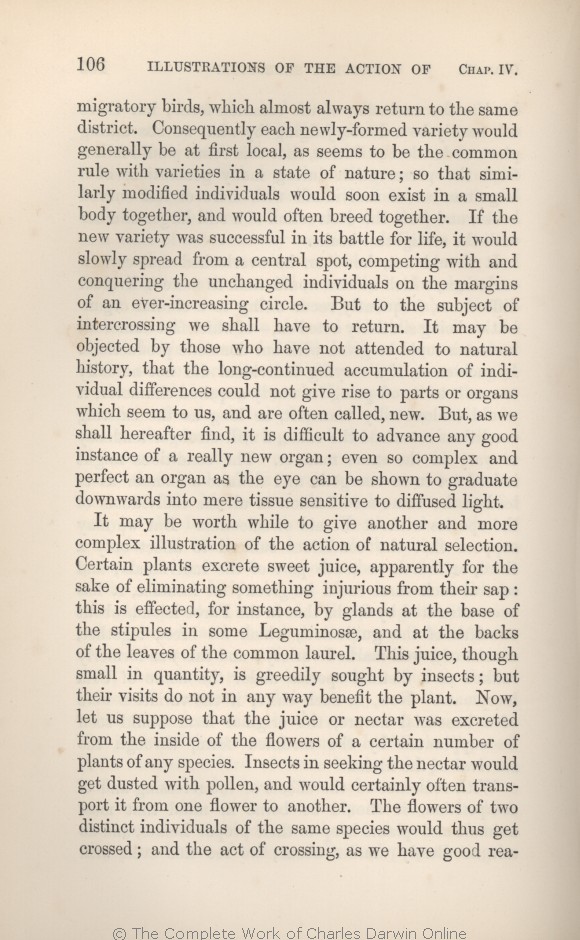migratory birds, which almost always return to the same
district. Consequently each newly-formed variety would generally be at first local, as seems to be the common rule with varieties in a state of nature; so that similarly modified individuals would soon exist in a small body together, and would often breed together. If the new variety
was
successful in its battle for life, it would slowly spread from a central
spot,
competing with and conquering the unchanged individuals on the margins of an ever-increasing circle. But to the subject of intercrossing we shall have to return. It may be objected by those who have not attended to natural history, that the long-continued accumulation of individual differences could not give rise to parts or organs which seem to us, and are often called, new. But, as we shall hereafter find, it is difficult to advance any good instance of a really new organ; even so complex and perfect an organ as the eye can be shown to graduate downwards into mere tissue sensitive to diffused light. ↑| 8 blocks not present in 1869 1872; present in 1859 1860 1861 1866 | | Even without any change in the proportional numbers of the animals on which our wolf preyed, a cub might be born with an innate tendency to pursue certain kinds of prey.
Nor can this be thought very improbable; for we often observe great differences in the natural tendencies of our domestic animals; one cat, for instance, taking to catch rats, another mice; one cat, according to Mr. St. John, bringing home winged game, another hares or rabbits, and another hunting on marshy ground and almost nightly catching woodcocks or snipes.
The tendency to catch rats rather than mice is known to be inherited.
Now, if any slight innate change of habit or of structure benefited an individual wolf, it would have the best chance of surviving and of leaving offspring.
Some of its young would probably inherit the same habits or structure, and by the repetition of this process, a new variety might be formed which would either supplant
or coexist with
the parent-form
of
wolf.
Or, again, the wolves inhabiting a mountainous district, and those frequenting the lowlands, would naturally be forced to hunt different prey; and from the continued preservation of the individuals best fitted for the two sites, two varieties might
slowly be formed.
These varieties would cross and blend where they met; but to this subject of intercrossing we shall soon have to return.
I may add, that, according to Mr. Pierce, there are two varieties of the wolf inhabiting the Catskill Mountains in the United States, one with a light greyhound-like form, which pursues deer, and the other more bulky, with shorter legs, which more frequently attacks the shepherd's
flocks.
|
|
It may be worth while to give another and | It may be worth while to give another and 1869 |
| Let us now take a 1859 1860 1861 1866 |
| illustration of the action of natural selection. 1869 |
| case. 1859 1860 1861 1866 |
| 1 blocks not present in 1859 1860 1861 1866 1869; present in 1872 | | It may be worth while to give another and more complex illustration of the action of natural selection.
|
| ..... 1869 1872 | | a 1859 1860 1861 1866 |
| eliminating 1859 1860 1861 1869 1872 | | elimi- nating 1866 |
| from, 1869 | | from 1859 1860 1861 1866 1872 |
| their 1859 1860 1861 1866 1869 | | the 1872 |
| effected, 1869 1872 | | effected 1859 1860 1861 1866 |
| for instance, by 1869 1872 |
| by 1859 1860 1861 1866 |
| backs 1869 1872 | | back 1859 1860 1861 1866 |
| leaves 1869 1872 | | leaf 1859 1860 1861 1866 |
| insects; but their visits do not in any way benefit the plant. 1869 1872 |
| insects. 1859 1860 1861 1866 |
| Now, let us suppose that the 1869 1872 |
| Let us now suppose a little sweet 1859 1860 1861 1866 |
| was excreted from the inside 1869 1872 |
| to be excreted by the inner bases 1859 1860 1861 1866 |
| flowers 1869 1872 | | petals 1859 1860 1861 1866 |
| certain number of plants of any species. 1869 1872 |
| flower. 1859 1860 1861 1866 |
| OMIT 1869 1872 |
| In this case 1859 1860 1861 1866 |
| Insects 1869 1872 | | insects 1859 1860 1861 1866 |
| certainly 1859 1860 1861 1866 1869 | certainly 1872 |
| it 1869 1872 | | the pollen 1859 1860 1861 1866 |
| another. 1869 1872 |
| the stigma of another flower. 1859 1860 1861 1866 |
| as we have good rea- son to believe, would produce 1869 |
| we have good reason to believe (as will hereafter be more fully alluded to), would produce very 1859 1860 1861 1866 |
| as can be fully proved, gives rise to 1872 |
|









